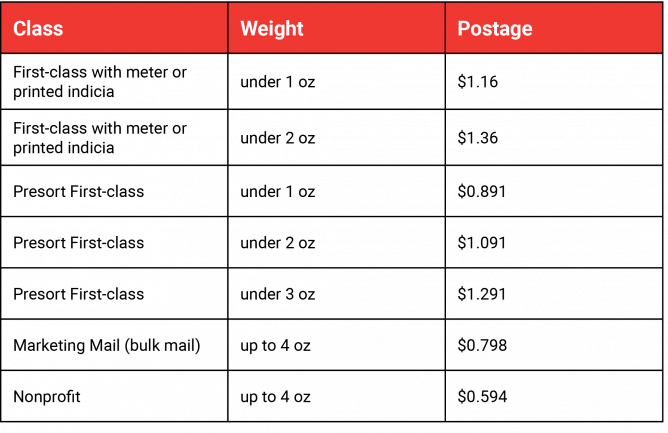Your Envelope Can Make or Break Your Direct Mail
Envelopes are perhaps the most underappreciated component of a direct mail package. Marketers tend to focus on the content that goes in them, leaving the carrier as an afterthought. But envelopes can impact your budget and the success of your campaign more than any other single piece. They’re often one of the most expensive and time-consuming things to print; they can determine your postage costs; and more importantly, envelopes influence whether your package even gets opened in the first place.
It’s time we give envelopes their due. Rather than waiting until the 11th hour to consider the carrier, it should be the very first step you take when planning your direct mail or invitation package. Your choice in envelope can affect the overall design and effectiveness of your direct mail, as well as your schedule and budget.
Design
When it comes to getting your direct mail opened, think about your own mailbox. What do you open and what do you toss without a second glance? Chances are, you made those decisions based on the envelopes alone. There’s a mix of psychology and art behind the size and design of direct mail. Bills and other official documents often come in #10 envelopes, so they tend to get opened, especially if you use teaser copy to create a sense of urgency. Hefty invitation-style packages create curiosity, while larger flats stand out in a sea of small mailers.
Envelopes are also a great place to test—try a different size, style, teaser copy, color, paper weight, or font. You can design your carrier to resemble a specific type of mailer (just be sure to follow USPS guidelines). Even changing your stamp design can make a difference. You’d be surprised at the lift in response rate you can get from making small, seemingly insignificant, changes to your outer envelope.
Timing
It’s important to think about your envelope at the beginning of your project because different options can have implications for your timeline. If you’re thinking of using specialty envelopes (like those made with colored paper, textures or finishes, or heavier paper weights), you might need to order them early. If pre-made envelopes aren’t available, you may need to print and convert your envelopes, which can add both time and cost to your project. And these days, availability is definitely a factor. Due to COVID, paper as well as envelopes will be in short supply through the winter of 2021-2022, so it’s essential to confirm availability and timing up front.
Cost
When it comes to your budget, the most important thing to consider when choosing the envelope for your direct mail package is size. The overall size of your carrier envelope can affect your printing and postage costs, as well as influence the design of the contents you put inside. From a postage perspective, envelopes fall into one of two main buckets: letters or flats. Generally speaking, letter size envelopes are smaller and less expensive to mail, but flats command more attention in the mailbox due to their larger size.
Below, we break down the specs, styles, and postage for some of the most popular envelope sizes for your reference. Still need some help choosing the right envelope for your project, schedule, and budget? Give us a call, we’re happy to help.

Envelope Sizes and Postage
Letter Size
- Maximum of 0.25” thickness
- Maximum size is 6.125” x 11.5”
- Square envelopes have a 20 cents surcharge
Here are the postage rates effective July 9, 2023.
Types of letter size envelopes:
#10 Envelopes
The standard size for a #10 envelope is 9.5 x 4.125, and they are available either closed-face (solid) or with a window.
- Closed-face: Commodity envelopes are available in 24# offset. Some text brands (Cougar and Accent) offer 60# (comparable to 24# bond) and 70# (comparable to 28# bond) in white.
- Window: Commodity #10 window envelopes can have up to three windows on the face of the envelope. Standard #10 envelopes can either have a regular window (size & position) or a larger window that’s big enough to contain USPS barcodes along with the address block.
Reply Envelopes
These smaller envelopes are meant to go inside an outer envelope and serve as a reply mechanism. They are available with either a standard flap or an extended flap and come in the following sizes:
- #9 Reply (8.875 x 3.875)
- #6 3/4 Reply (6.5 x 3.625)
Booklet and Catalog Envelopes
Booklet envelopes have the flap on the long side, whereas catalog envelopes have the flap on the short size. These are available in 24# and 28# weight and in many sizes. The most common letter-rate sizes are 6 x 9 and 6.5 x 9.
Announcement Envelopes
These envelopes feature a square flap and are used primarily for invitation packages or mailers “disguised” as invitations. The standard flap size requires hand inserting, so make sure to ask about “machineable flaps,” which are a little smaller.

Flat Size
- Maximum of 0.75” thickness
- Size Range: 6.125” x 11.5” minimum – 15” x 12” maximum
- No surcharge for square envelopes
Postage rates based on weight and service (rates as of August 29, 2021)

Types of flat size envelopes:
Booklet and Catalog Envelopes
Booklet envelopes have the flap on the long side, whereas catalog envelopes have the flap on the short size. These are available in 24# and 28# weight and in many sizes. The most common flat-rate sizes are 7 x 10, 9 x 12, and 10 x 13.
